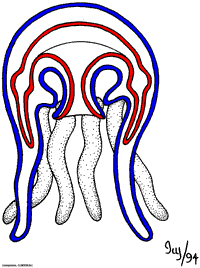| MadSci Network: Zoology |
Your teacher has challenged you with a very interesting question. Since you're taking an AP Biology course, I'm going to assume that your teacher has told you about basic cnidarian anatomy and get right to the heart of the matter.
Please refer to the following diagram of a cnidarian medusa in cross-section:

You already know that a cnidarian's body consists of two tissue layers, ectoderm (outer) and endoderm (inner) separated by a layer of jelly-like stuff called mesoglea. The ectoderm forms the outer layer of the body and the endoderm lines the animal's entire gut, called a gastrovascular cavity (GVC), which extends into each of the tentacles and functions as both digestive and circulatory systems. In the diagram, the ectoderm layer is blue, and the endoderm is red. The space between the red and blue lines would be filled with mesoglea, and the space surrounded by the red line would be the GVC.
You can see that the GVC in the diagram extends only partially into the tentacles. In actual jellies the tentacles are hollow and contain a tiny canal of GVC, called a tentacular canal. Armed with this information, plus what you already know about cnidarian anatomy, you should be able to answer your teacher's challenge.
I hope you get those extra credit points!
Allison J. Gong
MAD Scientist
Try the links in the MadSci Library for more information on Zoology.